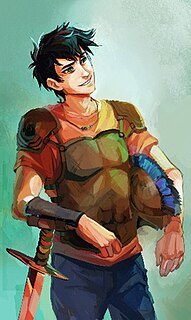Perseus is a figure in Greek mythology.
Contents
Perseus may also refer to:
Perseus is a figure in Greek mythology.
Perseus may also refer to:
Ajax may refer to:
Phoenix most often refers to:
Medusa is one of the three Gorgons in Greek mythology.
Mercer may refer to:
Alastor refers to a number of people and concepts in Greek mythology:
Athos may refer to:
Nestor may refer to:

Andromeda is one of the 48 constellations listed by the 2nd-century Greco-Roman astronomer Ptolemy, and one of the 88 modern constellations. Located in the northern celestial hemisphere, it is named for Andromeda, daughter of Cassiopeia, in the Greek myth, who was chained to a rock to be eaten by the sea monster Cetus. Andromeda is most prominent during autumn evenings in the Northern Hemisphere, along with several other constellations named for characters in the Perseus myth. Because of its northern declination, Andromeda is visible only north of 40° south latitude; for observers farther south, it lies below the horizon. It is one of the largest constellations, with an area of 722 square degrees. This is over 1,400 times the size of the full moon, 55% of the size of the largest constellation, Hydra, and over 10 times the size of the smallest constellation, Crux.

Perseus is a constellation in the northern sky, being named after the Greek mythological hero Perseus. It is one of the 48 ancient constellations listed by the 2nd-century astronomer Ptolemy, and among the 88 modern constellations defined by the International Astronomical Union (IAU). It is located near several other constellations named after ancient Greek legends surrounding Perseus, including Andromeda to the west and Cassiopeia to the north. Perseus is also bordered by Aries and Taurus to the south, Auriga to the east, Camelopardalis to the north, and Triangulum to the west. Some star atlases during the early 19th century also depicted Perseus holding the disembodied head of Medusa, whose asterism was named together as Perseus et Caput Medusae; however, this never came into popular usage.

In Greek mythology, Perseus is the legendary founder of Mycenae and of the Perseid dynasty. He was, alongside Cadmus and Bellerophon, the greatest Greek hero and slayer of monsters before the days of Heracles. He beheaded the Gorgon Medusa for Polydectes and saved Andromeda from the sea monster Cetus. He was the son of Zeus and the mortal Danaë, as well as the half-brother and great-grandfather of Heracles.
Hermes is the divine messenger of the Olympian gods in Greek mythology.
Draco is the Latin word for serpent or dragon.
Odin is the chief god of the Norse pantheon.

NGC 281, IC 11 or Sh2-184 is a bright emission nebula and part of an H II region in the northern constellation of Cassiopeia and is part of the Milky Way's Perseus Spiral Arm. This 20×30 arcmin sized nebulosity is also associated with open cluster IC 1590, several Bok globules and the multiple star, B 1. It collectively forms Sh2-184, spanning over a larger area of 40 arcmin. A recent distance from radio parallaxes of water masers at 22 GHz made during 2014 is estimated it lies 2.82±0.20 kpc. from us. Colloquially, NGC 281 is also known as the Pacman Nebula for its resemblance to the video game character.
Hercules is the Roman adaptation of the Greek mythological hero Heracles.
Chiron is a famous centaur from Greek mythology.

Arcadia is a region in the central Peloponnese. It takes its name from the mythological character Arcas, and in Greek mythology it was the home of the gods Hermes and Pan. In European Renaissance arts, Arcadia was celebrated as an unspoiled, harmonious wilderness; as such, it was referenced in popular culture.

Percy Jackson & the Olympians is a series of five fantasy novels written by American author Rick Riordan, and the first book series in the Camp Half-Blood Chronicles. The novels are set in a world with the Greek gods in the 21st century, and follows the protagonist Percy Jackson, a young demigod who must prevent the Titans, led by Kronos (Cronus), from destroying the world.

The Double Cluster consists of the open clusters NGC 869 and NGC 884, which are close together in the constellation Perseus. Both visible with the naked eye, NGC 869 and NGC 884 lie at a distance of about 7,500 light years in the Perseus Arm of the Milky Way galaxy.

Perseus "Percy" Jackson is a fictional character, the title character and narrator of Rick Riordan's Percy Jackson & the Olympians series. He is also one of seven main protagonists of the sequel series The Heroes of Olympus, appearing in every book except The Lost Hero, and appears in the Trials of Apollo series, making him one of the few characters to appear in all three series of the Camp Half-Blood chronicles. He has also been a narrator and protagonist in Riordan's Greco-Roman/Egyptian crossover stories, part of the Demigods and Magicians collection. The character serves as the narrator in Percy Jackson's Greek Gods and Percy Jackson's Greek Heroes, also by Rick Riordan.